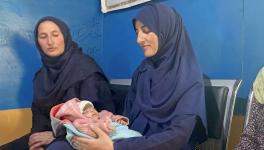NFHS Data Shows 60% Women Face Trouble Accessing Healthcare

Image Courtesy: Wikipedia
As many as 60% of women in the country face trouble accessing healthcare for themselves, the findings of the fifth round of the National Family Health Survey(NFHS) have revealed. The complete report— which had surveyed women between the ages of 15-49 years about potential problems in obtaining medical treatment for themselves when they are sick— was released early this month.
Inadequate infrastructure and insufficient health personnel emerged as the leading problem keeping women from accessing medical care. 40.4% of women reported non-availability of drugs as a problem, while 39.2% of women reported a lack of health providers as a cause for not accessing health care.
Further, 31.2% of women reported concerns about no female health provider available at healthcare centres. According to the National Health Profile 2021 (prepared by the Central Bureau of Health Intelligence), the country has 1,40,653 government allopathic doctors. Using the population projections used in the latest National Health Profile, one government allopathic doctor caters to over 9,679 people. The country has 33.41 lakh registered nursing personnel (including nurses, midwives, auxiliary nurse midwives (ANMs), and lady health visitors (LHVs)), minister of state for health ministry, Dr Bharatu Pravin Pawar, told the Rajya Sabha in April this year.
The National Family Health Survey (NFHS) identified at least eight problems that hindered women's access to healthcare.
"Three-fifths of women report at least one problem for themselves in obtaining medical care", the survey noted. At least 70.9% of tribal women reported at least one concern in getting healthcare—the highest figure for any group.
At least 21.4% of women cited money as a problem accessing medical care. According to the latest Health In India Report prepared by the National Sample Survey Organisation (NSSO), on an average, about Rs 3,350 were spent as out-of-pocket medical expenditure for hospitalisation (excluding childbirth) for rural women in a government hospital and Rs 4,100 were spent for urban women in a government facility.
In private hospitals, about Rs 21,898 in rural and Rs 28,988 in urban areas were spent on hospitalisation. The average out-of-pocket medical expenditure for non-hospitalised treatment/treated spell of ailment for rural women in government hospitals was Rs 285, and for urban women, it was Rs 336. In private hospitals, about Rs 1,024 in rural and Rs 1,135 in urban areas were spent on non-hospitalised treatment.
"There is a lot of inequality between men's and women's access to healthcare in India. Between the fourth and fifth round of the NFHS, we have not seen a great improvement in terms of women's access to healthcare," said Dr Prashanth N Srinivas, Assistant Director (Research), Institute of Public Health, Bengaluru.
The fourth round of the NFHS found that 66.5% of women reported at least one problem accessing medical care for themselves.
"Women's limited access to healthcare is a complex problem, and its reasons extend far beyond the inadequacies in the healthcare system. There are also social determinants that hinder women's access—less financial autonomy at home, power imbalance at home, among other various reasons," Srinivas said.
At least 23.2% of women reported distance to a health facility as a concern for accessing medical care, and 21.5% of women said having to take transport to reach a health centre was a problem for them. Around 13.5% of women said they didn't get permission to get medical treatment, while 16.7% could not find someone to accompany them to a facility.
The NFHS also found that only 10.1% of women (between 15-49 years of age) in the country could take independent decisions about their healthcare compared to 33.3% of men. The survey also reported that only 51.6% of women are allowed to go alone to a health facility.
"Despite all the social conditions that come in the way of women's access to healthcare, there is a strong need to make healthcare infrastructure women-friendly. So many community health centres (CHCs) don't even have space for attendants and patients to sit. There are no separate spaces made available for women who are breastfeeding in both private and public healthcare facilities (not that the act of breastfeeding should be covered-up or discrete, but many women feel uncomfortable in public spaces)," Srinivas said.
The NFHS also found that 29.8% of women were covered by health insurance compared to 33.3% of men (between 15-49 years of age). The prevalence of anaemia among women has also increased in the last five years; the NFHS found that 57% of the surveyed women were anaemic compared to 53.1% of women in 2016.
Get the latest reports & analysis with people's perspective on Protests, movements & deep analytical videos, discussions of the current affairs in your Telegram app. Subscribe to NewsClick's Telegram channel & get Real-Time updates on stories, as they get published on our website.
























